WEGA in the North West United States
Return to "Day" page
Return to Day 7 Page
Geological Background
YELLOWSTONE
The geology of Yellowstone is dominated by three extremely large explosive eruptions that took place over the past 2 million years forming three large calderas:
1) Island Park caldera formed at 2.0 Ma and was some 90 x 60 miles in size, it is now largely covered by younger flows. The deposit formed from this eruption is known as the Huckleberry Ridge tuff which covered an area of ~ 6,000 miles², with a total eruptive volume of ~ 600 miles³. In some areas the welded ash-flow tuffs from this eruption are more than 400 m thick!
2) Henry's Fork caldera formed at 1.2 Ma and is a smaller caldera of 16 km diameter and restricted to the Island Park area southwest of the Yellowstone Plateau. This event produced the Mesa falls tuff covering an area of 1050 miles², with a volume of 67 miles³.
3) Yellowstone caldera formed at 0.6 Ma, gave rise to the Lava Creek tuff covering an area of ~2900 miles² and with a volume of 240 miles³. The caldera formed was 28 wide by 46 miles long that dropped several hundred metres, and which has been filled by post-caldera flows and lake sediments.
Following the last caldera collapse at 0.6 Ma, magmatic resurgence has formed two structural domes:
- The Sour Creek dome in the northeast caldera began its uplift following the main eruption at 0.6 Ma, and
- The Mallard Lake dome in the southern caldera was initiated at 0.15 Ma.
Both of these domes are thought to have been produced by uplift above magmatic sources and are considered to be active volcanic features. There have also been 30 or more dominantly silicic volcanic eruptions in the park area since the last caldera eruption.
Previous research has shown the Yellowstone hotspot plume rises from a depth of at least 440 miles in the Earth’s mantle, with some postulating it comes from 1,800 miles depth. The plume conduit is ~ 50 miles wide as it rises 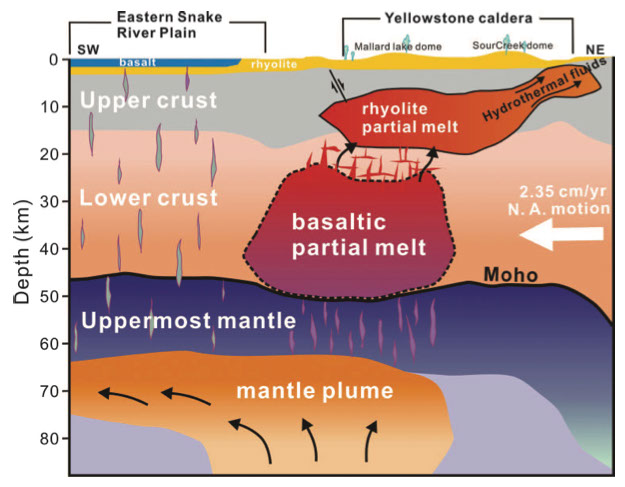 through the Earth’s mantle but then spreads out like a pancake at ~ 40 miles depth. Recent (2015) seismic imaging has identified a previously unknown, deeper and larger (11,200 mile³) basaltic magma reservoir, with about 2% molten rock. This reservoir is feed by hot and partially molten rock that rises in dykes from the top of the plume at 40 miles into the reservoir at ~ 28 miles depth. The top of this magma reservoir lies only at ~12 miles deep, and is 30 miles northwest to southeast and 44 miles southwest to northeast. A smaller (2,500 mile3) upper rhyolitic magma chamber lies 3 – 9 miles beneath the Yellowstone caldera, and averages about 9 % molten rock, equivalent to ~ 900 km3. It is this upper magma chamber that was the immediate source of three cataclysmic eruptions of the past 2 Ma.
through the Earth’s mantle but then spreads out like a pancake at ~ 40 miles depth. Recent (2015) seismic imaging has identified a previously unknown, deeper and larger (11,200 mile³) basaltic magma reservoir, with about 2% molten rock. This reservoir is feed by hot and partially molten rock that rises in dykes from the top of the plume at 40 miles into the reservoir at ~ 28 miles depth. The top of this magma reservoir lies only at ~12 miles deep, and is 30 miles northwest to southeast and 44 miles southwest to northeast. A smaller (2,500 mile3) upper rhyolitic magma chamber lies 3 – 9 miles beneath the Yellowstone caldera, and averages about 9 % molten rock, equivalent to ~ 900 km3. It is this upper magma chamber that was the immediate source of three cataclysmic eruptions of the past 2 Ma.
Hydrothermal features – it is estimated the park has ~ 10,000 such features. The geysers and hot springs are rich in chlorine and silica and have a pH around 9, and these make up around 80 to 90 % of the park's total water discharge.
Geyser – is a hot spring that periodically very hot water into the air. This water is derived from groundwaters forming a convective cell around the magma reservoir in the crust. At depth the water is superheated because of the elevated pressure, but as it rises in the cell and pressure drops steam bubbles form. These bubbles increase in size as the water rises until they are too numerous and large to pass freely through constrictions in the pathway. At a critical point the confined bubbles lift the water above them causing the geyser to overflow. This decreases the pressure of the system and further violent boiling results. Large quantities of water flash (i.e. water converting to steam represent a volume increase of some 1800x) into tremendous amounts of steam that force a jet of water out of the vent: an eruption begins. Water and heat is expelled faster than the geyser’s recharge rate, gradually decreasing the system’s pressure and eventually ending the eruption. The periodicity of these eruptions is a function of several factors, including the amount of water flux, the amount of dissolved gases, the temperature, the duration of the previous eruption, and the size of the constriction.
Hot Springs are the most common thermal feature in the park. Their fluid pathways don’t have the restrictions of the Geyer pathways and so as the superheated water reaches the surface it rapidly cools and then sinks and is replaced by hotter water from depth.
Fumaroles (also called steam vents) are the hottest hydrothermal features in the park. They are basically cracks at the surface in areas where there is relatively little groundwater and this is flashed into steam which escapes along the fractures They have so little water that it all flashes into steam before reaching the surface with sufficient force to give a hissing or roaring sound.
Mudpots are acidic hot springs with limited water supply. The acidity arises by bacteria breaking down sulphur in the rocks into sulphuric acid which readily breaks down the glass and feldspars in the rocks to clay minerals.
Travertine terraces as at Mammoth Hot Springs are formed where the bedrock is limestone. The hot acidic waters rise through the limestone and dissolve carbonate. As the waters emerge at the surface, the CO2 is released from the water causing the dissolved carbonate to precipitate as travertine.
Thermophilic Microbes
The varieties of microbes found in the hot springs are thermophilic archaea and bacteria that are “heat loving” organisms that can tolerate at temperatures that many organisms can’t survive. The temperature range is from 30º to 100º C with a variable pH range and low concentration of organic matter. The bluish areas of the pools represent the highest temperatures (100°C +) where it is too hot to support any of the bacterial species. The hot pools of the springs vary in colour due to the thermophile pigmentation when exposed to sunlight and are divided into the following types:
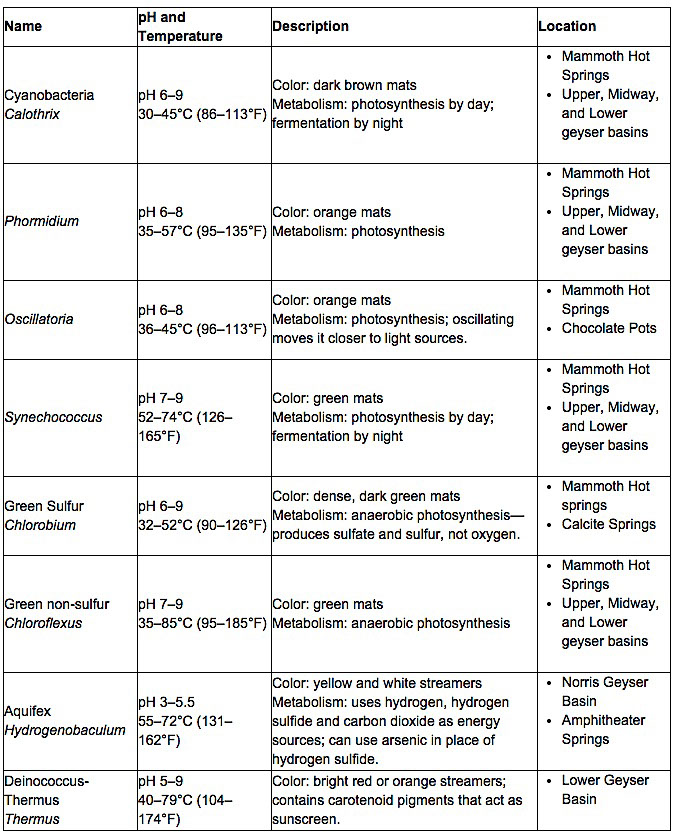
Island Park Caldera
The Island Park Caldera is one of the world's largest calderas, with approximate dimensions of 80 by 65 km. Its ashfall is the source of the Huckleberry Ridge Tuff that is found from southern California to the Mississippi River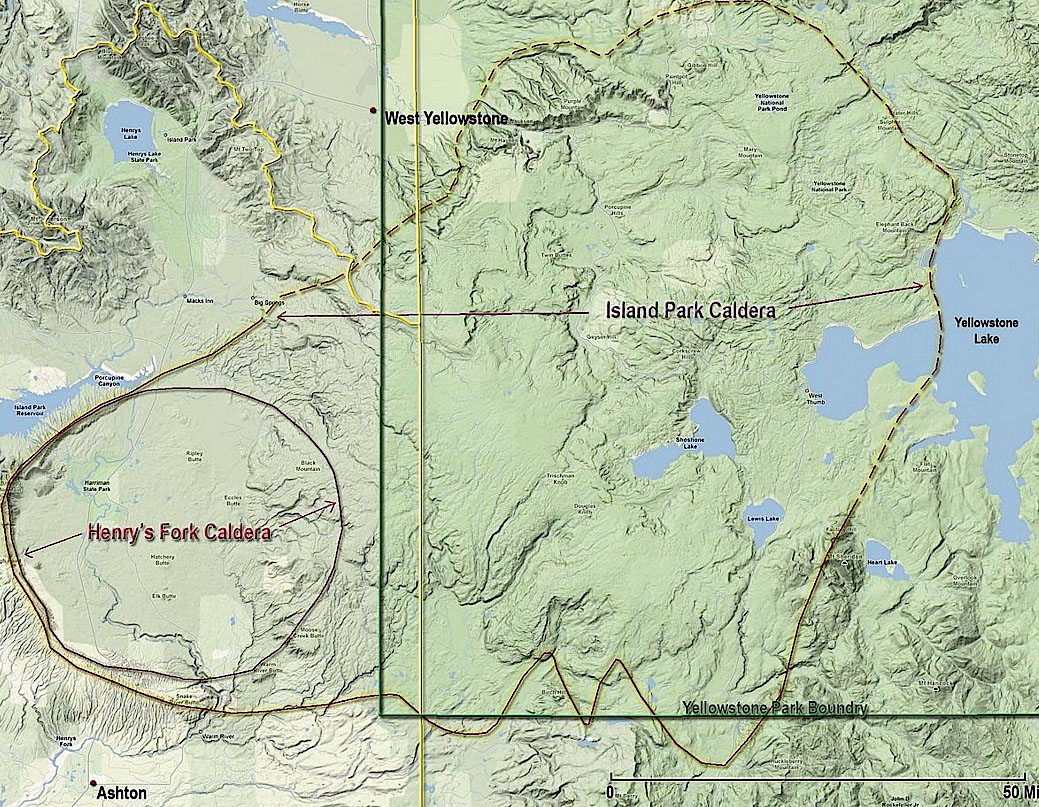 near St. Louis. This supereruption of ~ 2,500 km³ occurred at 2.1 Ma and produced 2,500 times as much ash as the 1980 Mt St Helens eruption. Island Park Caldera has the smaller and younger Henry's Fork Caldera nested inside it. The caldera clearly visible today is the later Henry's Fork Caldera, which is the source of the Mesa Falls Tuff. It was formed in an eruption of more than 280 km³ at 1.3 Ma. The two nested calderas share the same rim on their western sides, but the older Island Park Caldera is much larger and more oval and extends well into Yellowstone Park.
near St. Louis. This supereruption of ~ 2,500 km³ occurred at 2.1 Ma and produced 2,500 times as much ash as the 1980 Mt St Helens eruption. Island Park Caldera has the smaller and younger Henry's Fork Caldera nested inside it. The caldera clearly visible today is the later Henry's Fork Caldera, which is the source of the Mesa Falls Tuff. It was formed in an eruption of more than 280 km³ at 1.3 Ma. The two nested calderas share the same rim on their western sides, but the older Island Park Caldera is much larger and more oval and extends well into Yellowstone Park.
UPPER GEYSER BASIN
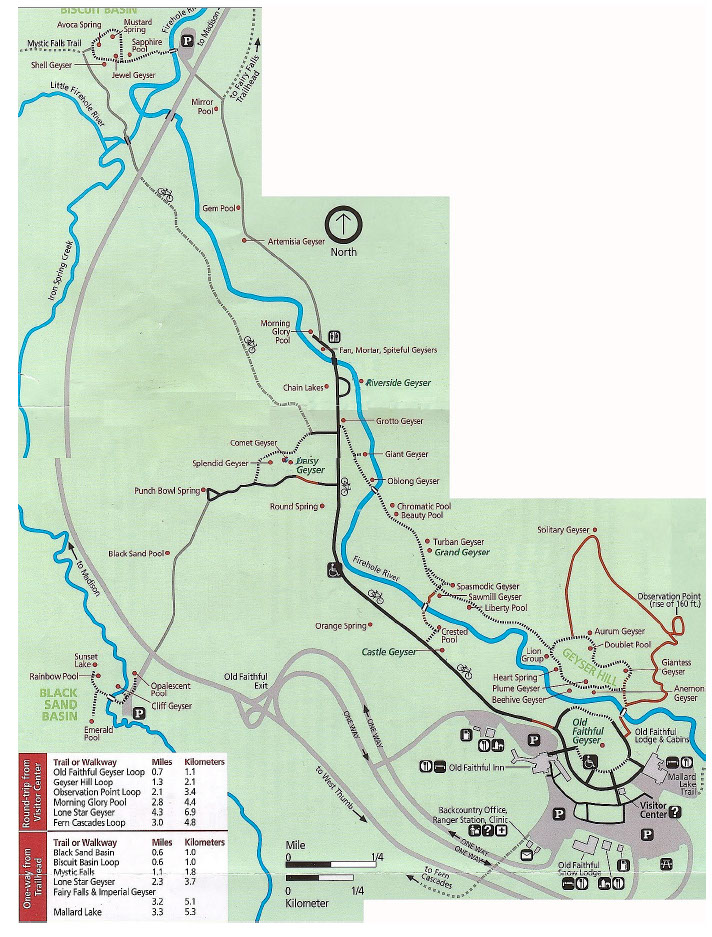 This basin is underlain by the 516 ka Biscuit Basin rhyolitic lava flow along the Firehole River basin, which is flanked on the east by the bluffs of the Mallard Lake flow (151 ka) and on the west by the Summit Lake Flow (108 ka). The hot springs and geysers of this area transect mainly rhyolitic lava flow en route to the surface, and due to reaction with rhyolitic glass carry abundant silica that is deposited as sinter at the surface. Upper Geyser Basin contains the largest concentration of active geysers in the World, including Old Faithful, Beehive, Giantess, Lion Group, Castle, Grand, Grotto, and Riverside. The thermal waters are of the neutral pH-chloride type rising from a 215°C reservoir. Studies of δD and δ18O has shown that there is a deep reservoir of hydrothermal fluid underlying the caldera that is mainly meteoric water at 350-400°C. The deep reservoir fluid is isotopically lighter than present-day surface and groundwater in YNP and likely is a mixture of modern waters and waters derived from the last glacial epoch. Boiling and conductive cooling of this deep reservoir fluid produces shallower reservoir fluids at temperatures around 200 - 220°C. The geochemical characteristics of shallower reservoir fluids depends on boiling, mixing with local groundwater, and water-rock reaction.
This basin is underlain by the 516 ka Biscuit Basin rhyolitic lava flow along the Firehole River basin, which is flanked on the east by the bluffs of the Mallard Lake flow (151 ka) and on the west by the Summit Lake Flow (108 ka). The hot springs and geysers of this area transect mainly rhyolitic lava flow en route to the surface, and due to reaction with rhyolitic glass carry abundant silica that is deposited as sinter at the surface. Upper Geyser Basin contains the largest concentration of active geysers in the World, including Old Faithful, Beehive, Giantess, Lion Group, Castle, Grand, Grotto, and Riverside. The thermal waters are of the neutral pH-chloride type rising from a 215°C reservoir. Studies of δD and δ18O has shown that there is a deep reservoir of hydrothermal fluid underlying the caldera that is mainly meteoric water at 350-400°C. The deep reservoir fluid is isotopically lighter than present-day surface and groundwater in YNP and likely is a mixture of modern waters and waters derived from the last glacial epoch. Boiling and conductive cooling of this deep reservoir fluid produces shallower reservoir fluids at temperatures around 200 - 220°C. The geochemical characteristics of shallower reservoir fluids depends on boiling, mixing with local groundwater, and water-rock reaction.
The Old Faithful eruptions expel 14,000 to 32,000 l of boiling water to a height of 32 to 56 m lasting from 1.5 to 5 minutes. The average height of an eruption is 44m. Intervals between eruptions can range from 45 to 125 minutes, the average timing was 66.5 minutes in 1939, and has slowly increased to present-day value of 90 minutes.
Riverside geyser: Temperature 201.2°F Interval 5-7 hours. Duration 20 minutes. Height 75 feet. Riverside is an isolated geyser, with its own plumbing system, and it has regular, predictable eruptions. About one to two hours before an eruption water begins to overflow and surge in the crater. Forty to 50 minutes before an eruption water may boil and splash from the crater. A heavy surge or splash then triggers an eruption. The column of water arches over the Firehole River at about a 70° angle and at times spans the width of the River. The eruption peaks during the first five minutes and then begins to subside gradually, followed by a steam phase.
Beehive geyser: Temperature 199°F Interval 7 hours to days (dormancy). Duration 4-5 minutes. Height 150-200 feet. The cone is three and a half feet high with a four foot diameter. Beehive, considered one of the largest active geysers in the world, erupts to a height of 200 feet. However, since its discovery, it has been unpredictable. It has eruptive intervals of eight to twelve hours, but it has infrequent eruptions as long as 3 to 10 days and dormancy of weeks to months. An eruption begins with occasional splashing, then small surges. These progress into an eruption as the ground rumbles and a narrow, straight fountain of water jets upward.
Grand Geyser: Temperature 201°F Interval 6-15 hours. Duration 9-16 minutes. Height 140-200 feet. The power and spectacle of a Grand Geyser eruption inspired the name given by the 1871 Hayden Expedition. It is one of the few major geysers that has not changed considerably since its early discovery. This fountain-type geyser erupts from a shallow basin which slowly fills with water over a 5 hour period. Two adjoining geysers, Turban and Vent, are separated by a thin narrow bridge. Grand's eruptive cycle depends on the activity of these two geysers and West Triplet and Rift geysers. Grand only erupts at the start of a Turban active period. A slight ebb in Turban's eruption may signal an eruption of Grand with an explosion, pulsating vibration, and jets of water. During eruption Grand usually has 1 to 6 bursts lasting 1 to 10 minutes each.
Castle Geyser: Temperature 200°F Interval 9-11 hours. Duration 1 hour. Height 60-90 feet. It is named for the resemblance to the ruins of an old castle. The large sinter cone is nearly 12’ high with a diameter of 20’ at the top. Castle was an irregular geyser, with periods of dormancy, before the 1959 earthquake. Since the earthquake, it has been a regular, easily predictable geyser. The water phase of an eruption lasts about 15 minutes and a steam phase, similar to a steam locomotive, lasting an additional 45 minutes.
Morning glory pool: Temperature 171°F Dimensions 23x26.6 feet. Depth 23 feet. A deep, funnel-shaped pool with a dark blue centre. The resemblance to the corolla and colour of a morning glory is responsible for its name in the early 1880s. Bacteria grow in the cooler yellow and orange edges of the pool.
LOWER GEYSER BASIN - part 1
The Lower Geyser Basin encompasses nearly 12 square miles, with most of the thermal features widely scattered in small groups. There is a large variety of thermal features, including mud pots, geysers, pools, springs, 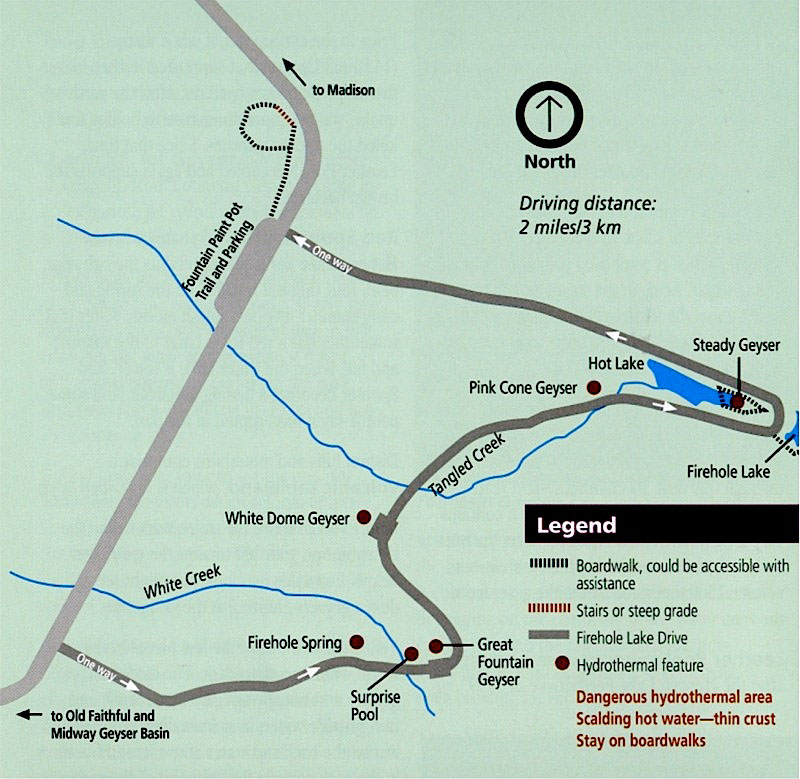 and fumaroles. Great Fountain Geyser is one of the grand geysers in the Lower Geyser Basin. It erupts from a large, terraced platform with massive bursts exploding up to 150 feet high.
and fumaroles. Great Fountain Geyser is one of the grand geysers in the Lower Geyser Basin. It erupts from a large, terraced platform with massive bursts exploding up to 150 feet high.
Great Fountain Geyser: Temperature 202°F Interval 8-12 hours. Duration 45-60 minutes. Height 75-150 feet. The intricately terraced sinter cone is 150 feet in diameter with a 14x20 foot crater. Eruptions begin about one hour after the crater fills and the first overflow spills onto the terraces. The overflow period is longer in spring and fall. A few minutes before the eruption water violently surges and boils, starting an eruption. Bursts may reach up to 200 feet, but average 100 feet. The hour-long eruption has several phases.
Steady Geyser: Temperature 199°F Interval none. Duration constant. Height 2-15 feet. It is the largest constantly erupting geyser in Yellowstone and the world. Steady Geyser, located on the edge of a small lake near Hot Lake, has a dark gray-brown mound, coloured by manganese oxide, built in an irregular mass of geyserite. This geyser has two vents and at times one vent may become dormant while the other continues to erupt.
MIDWAY GEYSER BASIN
Across the basin to the west are the steep walls of the West Yellowstone rhyolite flow (117,000 ka). This Basin contains a small collection of mammoth-sized springs. Despite its small size Midway possesses two of the largest hot springs in the world. Across the Firehole River from Excelsior and Grand Prismatic springs are a series of small isolated, pristine springs and mud pots.
Grand Prismatic Spring: Temperature 147 - 188°F Dimensions 250x380 feet. Grand Prismatic is the largest hot spring in Yellowstone, and is considered to be the third largest in the world - New Zealand has the two largest springs. Grand Prismatic sits upon a wide, spreading mound where water flows evenly on all sides forming a series of small, stair-step terraces. The spring has beautiful colouration that begins with a deep blue centre (~212°F) followed by pale blue. Green algae forms beyond the shallow edge. Outside the scalloped rim a band of yellow fades into orange. Red then marks the outer border. Steam often shrouds the spring which reflects the brilliant colours. Grand Prismatic discharges ~ 560 gallons per minute.
spring in Yellowstone, and is considered to be the third largest in the world - New Zealand has the two largest springs. Grand Prismatic sits upon a wide, spreading mound where water flows evenly on all sides forming a series of small, stair-step terraces. The spring has beautiful colouration that begins with a deep blue centre (~212°F) followed by pale blue. Green algae forms beyond the shallow edge. Outside the scalloped rim a band of yellow fades into orange. Red then marks the outer border. Steam often shrouds the spring which reflects the brilliant colours. Grand Prismatic discharges ~ 560 gallons per minute.
Excelsior Geyser: Temperature 199°F Dimensions 276x328 feet. Excelsior was once the largest geyser in the world, but its last known major eruptions occurred during the 1880s, when there were numerous eruptions up to 300 feet. The violent eruptions of the 1880s may have caused damage to the siliceous sinter lining, allowing gas leakage and the loss of thermal energy. No observed eruptions were known until 1985 when it erupted for two days. Excelsior is now a productive thermal spring, discharging ~ 4050 gallons per minute. Numerous vents boil and churn the water within the crater, covering it in a dense layer of steam
Turquoise Pool: Temperature 142-160°F Dimensions 100x110 feet. The pool has a milky, white bottom and gem-like, blue-coloured water. Suspended mineral particles in the water also add an opalescent iridescence. Turquoise has no apparent overflow channel, instead water drains through seepage. In June and July purple fringed gentians are common and bloom on the barren ground surrounding this pool.
LOWER GEYSER BASIN - part 2
Fountain Paint Pot: Temperature 202.8°F Dimensions 80x40 feet. The mud is composed of clay and fine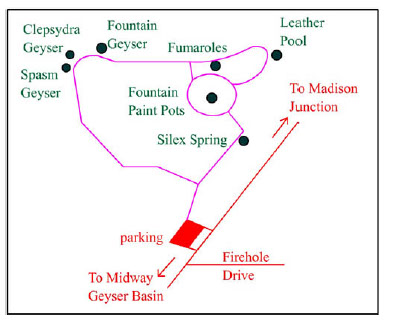 particles of silica broken down by acids. The tinting of the mud in colours of pink and gray from iron oxides is derived from the original rock. The bubbling action results in escaping steam and gases - mainly carbon dioxide and hydrogen sulphide. In the spring and early summer the mud is thin and the pots boil. By late summer and fall there is less moisture and the mud is thicker, creating unusual shapes and formations.
particles of silica broken down by acids. The tinting of the mud in colours of pink and gray from iron oxides is derived from the original rock. The bubbling action results in escaping steam and gases - mainly carbon dioxide and hydrogen sulphide. In the spring and early summer the mud is thin and the pots boil. By late summer and fall there is less moisture and the mud is thicker, creating unusual shapes and formations.
Return to Day 7 Page
May 29th to June 11th 2016